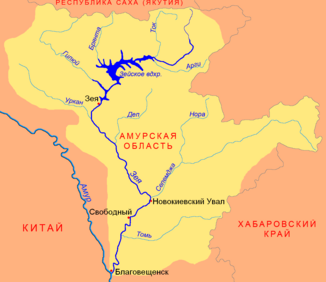Giljui
|
Giljui Гилюй |
||
|
Location of the Giljui (Гилюй) in the catchment area of the Seja |
||
| Data | ||
| Water code | RU : 20030400112118100027771 | |
| location | Amur Oblast ( Russia ) | |
| River system | Amur | |
| Drain over | Seja → Amur → Tatar Sound | |
| source |
Stanowoy Mountains 55 ° 29 ′ 9 ″ N , 126 ° 13 ′ 43 ″ E |
|
| Source height | approx. 700 m | |
| muzzle |
Seja Reservoir Coordinates: 53 ° 58 '49 " N , 127 ° 27' 36" E 53 ° 58 '49 " N , 127 ° 27' 36" E |
|
| Mouth height | approx. 315 m | |
| Height difference | approx. 385 m | |
| Bottom slope | approx. 0.71 ‰ | |
| length | 545 km | |
| Catchment area | 22,500 km² | |
| Right tributaries | Mogot , Tynda | |
The Giljui ( Russian Гилюй ) is a 545 kilometer long right tributary of the Seja in the Far East of Russia ( Asia ).
course
The Gilyuy River originates in approximately 700 m height from the two short (10-15 km) headwaters Left Gilyuy River (Lewy Gilyuy River) and Right Gilyuy River (Prawy Gilyuy River) , which on the south side of the main ridge of this central mountain character carrying Stanowoigebirges in just under 1,000 m spring height . First, the Giljui flows on the southern edge of the mountains in a south-westerly to westerly direction, only to turn sharply to the south-east near the city of Tynda . It flows in wide arches through the larch taiga north of the Tukuringra Mountains .
The Giljui enters the Tukuringra Mountains, which it cuts through in a narrow and rocky valley, a good 100 kilometers above its mouth in the Seja , which is dammed up here to form the Seja reservoir . About 70 kilometers of the Giljui lower reaches lie in the reservoir area of the Seja dam .
The Giljui flows through the territory of Amur Oblast along its entire length .
The largest tributaries are Mogot and Tynda from the right. In the catchment area of the river there are around 400 lakes with a total area of 27 km², mainly on the middle reaches.
Hydrography
The catchment area of the Giljui covers 22,500 km². Above the confluence with the Seja reservoir, the river reaches a width of over 100 meters and a depth of four meters; the flow rate is 1.6 m / s.
Economy and Infrastructure
The Giljui is not navigable. The lower reaches of the Seja reservoir are not used for shipping because its banks are uninhabited here.
The entire area crossed by the river is also sparsely populated. Just east of the central town of Tynda, which is a few kilometers from the Giljui on the tributary of the same name, the Baikal-Amur mainline and the parallel road follow the river for almost 100 kilometers (stations Schachtaum to Marewaja ). The railway line crosses the Giljui three times, as well as the Amur-Yakut Magistrale branching off east of Tynda once .
In the area of the Giljui lower reaches and its tributaries gold mining has been practiced since the 19th century as part of the Seja gold fields , but today this has practically come to a standstill in favor of other extraction areas.
